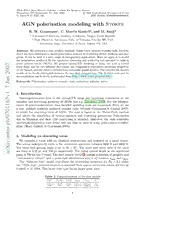
AGN polarization modeling with STOKES PDF
Preview AGN polarization modeling with STOKES
Black Holes: from Stars to Galaxies – across the Range of Masses Proceedings IAU Symposium No. 238, 2006 (cid:13)c 2006International AstronomicalUnion V. Karas & G. Matt, eds. DOI:00.0000/X000000000000000X Stokes AGN polarization modeling with R. W. Goosmann1, C. Martin Gaskell2, and M. Shoji3 1 Astronomical Institute,Academy of Sciences, Prague, Czech Republic 2 Dept.Physics & Astronomy,Univ.of Nebraska, Lincoln, NE, USA 3 Astronomy Dept., Universityof Texas, Austin,TX, USA Abstract.Weintroduceanew,publiclyavailableMonteCarloradiativetransfercode,Stokes, whichhasbeendevelopedtomodelpolarizationinducedbyscatteringofffreeelectronsanddust grains. It can beused in a wide range of astrophysical applications. Here,we apply it tomodel the polarization produced by the equatorial obscuring and scattering tori assumed to exist in 7 active galactic nuclei (AGNs). We present optical/UV modeling of dusty tori with a curved 0 inner shape and for two different dust types: one composition reproduces extinction properties 0 ofourGalaxy,andtheotherisderivedfromcompositequasarspectra.Thepolarizationspectra 2 enable us to clearly distinguish between the two dust compositions. The Stokes code and its n documentation can be freely downloaded from http://www.stokes-program.info/. a Keywords. Polarization, radiative transfer, dust,extinction, galaxies: active J 7 1 1. Introduction v 5 Spectropolarimetric data in the optical/UV range put important constraints on the 6 emission and scattering geometry of AGNs (see e.g. Antonucci 2002). For the interpre- 1 tation of spectropolarimetric data detailed modeling tools are important. Here, we use 1 a new, publicly available radiative transfer code, Stokes (Goosmann & Gaskell 2007), 0 7 to model the obscuring torus of AGNs. The code is based on the Monte-Carlo method 0 and allows the simulation of various emission and scattering geometries. Polarization / due to Thomson and dust (Mie-)scattering is included. Moreover, the code computes h p wavelength-dependent time delays and can thus be used to study polarization reverber- - ation (Shoji, Gaskell, & Goosmann 2005). o r t s 2. Modeling an obscuring torus a v: We consider a torus with an elliptical cross-section and centered on a point source. i The source isotropically emits a flat continuum spectrum between 1600 ˚A and 8000 ˚A. X The torus half-opening angle is set to θ0 = 30◦. The inner and outer radii of the torus r are fixed at 0.25 pc and 100 pc respectively. The radial optical depth in the equatorial a planeis750fortheV-band.Thedustmodels(table1)assumeamixtureofgraphiteand “astronomicalsilicate” and a grain radii distribution n(a)∝aαs between amin and amax. The “Galactic dust” model reproduces the interstellar extinction for RV = 3.1 whilst the “AGN dust” parameterization is obtained from quasar extinction curves derived by Gaskell et al. 2004. This latter dust type favors larger grain sizes. Table 1. Parameterization of thedust models Type Graphite Silicate amin amax αs Galactic 62.5% 37.5% 0.005µm 0.250µm −3.5 AGN 85% 15% 0.005µm 0.200µm −2.05 1 2 Goosmann, Gaskell & Shoji i = 18° i = 18° i = 32° i = 32° i = 41° i = 41° 0.2 i = 49° 0.2 i = 49° i = 57° i = 57° i = 63° i = 63° i = 70° i = 70° P P 0.1 0.1 0.0 0.0 1 1 1100--11 1100--11 nt nt e e Fc10-2 Fc10-2 F / F / 1100--33 1100--33 10-4 10-4 2000 3000 4000 5000 6000 7000 8000 2000 3000 4000 5000 6000 7000 8000 λ [Angstroem] λ [Angstroem] Figure 1. Polarization (top) and flux (bottom) spectra for a centrally-illuminated torus filled with “Galactic dust” (left) or “AGN dust” (right). The flux spectra are normalized to the illuminating fluxand theinclination angle i is measured from thesymmetry axis. 3. Results and discussion The angular distributions of the polarization and flux spectra are shown in figure 1. In a face-on view, the central source is seen directly and the obtained polarization is low.At obscuredinclinations i>θ0, the scatteringproperties of both dust types leadto different results. For “AGN dust”, the polarization is lower in the UV but rises quickly toward longer wavelengths. Detailed spectropolarimetric observations of dust reflection thus effectively constrain the dust composition. For both dust types the polarization position angle is oriented perpendicularly to the projected symmetry axis of the object. Ifthetorusisfilledwith“AGNdust”thetotalfluxspectraarewavelength-independent above 2500 ˚A at all possible inclinations. For the “Galactic dust” model the scattered flux rises gradually toward longer wavelengths. The albedo of both dust compositions changes significantly below 2500 ˚A so that less radiation is scattered in the UV. SpectropolarimetricdatafromAGNscontainnotonlyinformationabouttheobscuring torus, but also include other scattering regions. To obtain a more detailed picture of AGNpolarizationitisthereforenecessarytomodelseveral,radiativelycoupledscattering regionsself-consistently.Whilethisisbeyondthescopeofthisproceedingsnote,Stokes is capable of solving such problems. References Antonucci,R.2002, Astrophysical Spectropolarimetry, 151 Gaskell, C.M., Goosmann, R.W., Antonucci,R.R.J. & Whysong, D.H.2004, ApJ, 616, 147 Goosmann, R.W. & Gaskell, C.M. 2005, submitted to A&A,astro-ph/0507072 Shoji, M., Gaskell, C.M., Goosmann, R.W. 2005, Bulletin of the AAS, 37, 1420
